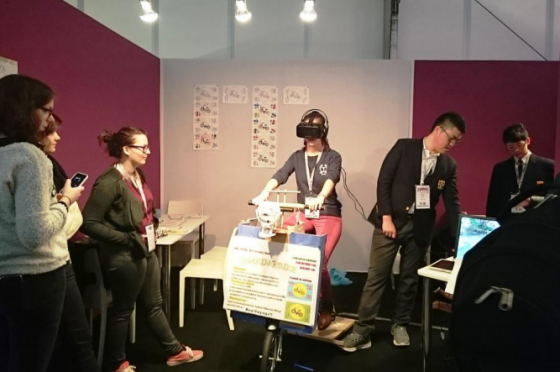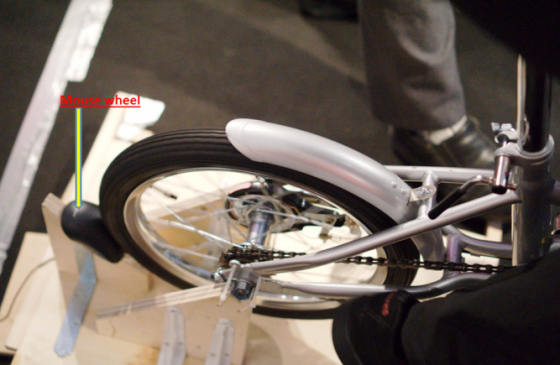A Tokyo high school team creates a virtual reality ride.
At the Laval Virtual conference, there was an emerging technologies section, similar to Siggraph, where innovative and surprising exhibits could be found. Time pressure prevented us from interviewing them all, which was a shame because there were many wonderful applications. However, one stood out for its imaginative use of components and concept: the Soaring Bike. We called it E.T’s Bike, but obviously Steven Spielberg wouldn’t like that.
Before you can ride the Soaring Bike, you are asked to color in (with magic markers) a drawing with a bike in the center, and flowers in the corners.

The drawing is then photographed and used as a target for the rider, and since you colored it, you recognize it.
The ride consists of pedaling toward the drawing the rider has colored. The photo shows the setup of the Soaring bike as exhibited at the Laval Virtual conference.

The Soaring Bike consists of a stunt bike in a floor mount so it stands upright by itself with the rear wheel slightly above the platform so it can spin when you pedal. The floor mount is a simple plywood platform set up like a seesaw.
As you pedal, the platform is flipped from its back position (with the rear wheel lower) to its forward position, which lifts the rear wheel; the effect is surprising and adds to the fun and immersion.
A mouse wheel mounted under the rear tire, as shown in the photo, tracks the pedaling.
The handlebar can be raised or lowered by the rider, as well as turned. You raise the handlebar to go (fly) up, and visa-versa. The up-down motion is tracked by a joystick in a game controller, and connected with a string. Likewise, the turning (steering) is also connected to the controller and uses the other joystick.

In addition, a small fan is mounted in the front to give the sensation of forward movement.
You, as the rider, are trying to get home, and you do that by pedaling toward the drawing you colored in. Arrows appear to help guide you if you wander off.
The ride’s virtual world and visuals were made with the Unity game engine, and overall the Soaring Bike costs $66 in parts (not counting the bike, PC, or virtual reality head-mounted display). The ride only lasts 3 minutes, which is just long enough to minimize VR sickness.
What do we think?
The Rikkyo Ikebukuro High School kids and their advisor have built an amusement VR ride. It’s not clear if that was their intent or not, but the potential is obvious. The ride has action (steering, lifting the handlebar, and pedaling), motion (the see-saw board and the wind effect), and of course, the virtual world seen through a VR headset. The ride time is short, perfect for an amusement ride and preventing VR sickness.
It could easily be extended to allow people to ride together and/or against each other.
We think this is one of the most innovative, clever, and amusing applications of VR we’ve ever seen, and predict the developers should be able to license it to a amusement parks all over the world. Those parks, BTW, are very anxious to get VR rides.





